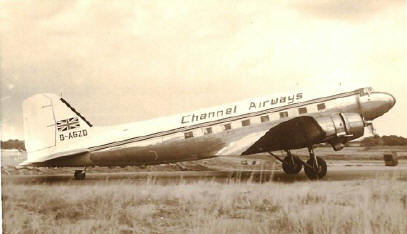Most of Channel's problems seem in hindsight to have revolved around this 270 acre
grass airfield, situated just 12 feet above sea level and built on marshland next
to the shoreline of Portsea Island. Although it had been well used before the war,
it was never fully developed by the Council who owned the site and although at the
forefront of South Coast aviation, it was never regarded by the authorities as much
more than a large flying field with a passenger terminal. As we shall see, this
was to be a fundamental aspect of the accident. Portsmouth airport was always the
poor relation and when in 1967 two Channel Airways HS.748 aircraft slid off the grass
following a heavy rain shower, the airport began to decline, finally closing in 1973
when it was redeveloped for housing.
However in 1962, Portsmouth was Channel's newest operating base and they were the
first operator since the end of the war to bring passengers there direct from Europe.
The Portsmouth - Channel Islands service was also the fastest direct link from the
mainland and to cater for the traffic, Channel Airways built their own terminal building
adjacent to the Southsea - Portsmouth dual carriageway to provide easy road access.
The terminal included a restaurant, cocktail bar and Customs Hall and was a major
investment for the airline.
It is almost beyond comprehension that the local Council and the Air Ministry did
not respond in kind. Given the amount of trade being brought to the city by Channel
Airways, which had turned a backwater flying field into a thriving airport with daily
international connections, there was almost no improvement in facilities, and incredibly
no air traffic control system or communications. Despite all the traffic that was
using the facility by 1962, there was no approach radar, the nearest being at Thorney
Island and operated by the RAF (but not as we shall see at the weekends ),no modern
landing aids and the standard approach and landing was flown by ‘turning left at
the Phillips factory neon sign’.
However one of the key factors of this accident was that there was no method of communicating
with aircraft other than by use of a very pistol and coloured flares technology from
the First World War. Hence the only way for a crew to know if the runway visibility
was sufficient or even if the runway was clear was to try a landing approach - with
the risk of flying into buildings, the ground or collisions with other aircraft.
Even in 1962 this is difficult to comprehend. All for the sake of the outlay on
a radio set.

